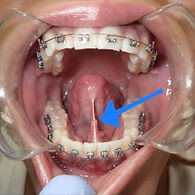

Myofunctional Partners
Your Partners in Oral Function & Facial Development
(424) 835-2759
Why should I care about my oral muscles and breathing?
It's about getting oxygen to your body. Medical and dental professionals are united to address airway issues. When we have problems with small upper airway space, we often experience poor sleep quality and lack of oxygen to the brain, which has a domino effect on the rest of the body. Lots of things can lead to upper airway problems, including what we call "low tongue rest posture". When this tongue position is present, the muscles in the face and mouth don't function properly and can crowd the back of the mouth with lazy muscles. This can lead to skeletal changes and can make it difficult to breathe properly.
Low tongue rest posture can develop because of:
Habitual mouth breathing
Thumb, finger, pacifier and other habits
Lack of breastfeeding
Tongue-Ties (Ankyloglossia)
Check out the links below to learn more.
Sleep Apnea, Oral Breathing, Dental Health and General Wellness
Dr. Mark Burhenne talks with Dhru Purohit from the Broken Brain Podcast about the importance of airway and how your airway centric oral health team can catch early signs of airway problems. Of utmost importance are nasal breathing and tongue function. https://youtu.be/eabZ25f8pCU
Our Incredible Shrinking Faces
Why did Grandma have room for all her teeth (wisdom teeth included) and had nearly perfectly straight teeth without the need for orthodontics, but our kids have impacted or missing wisdom teeth and often need other teeth extracted for braces? It's because our jaws are shrinking with each generation. If you work in family practice dentistry, you can see this happening. Diet is a big part of why this is happening. Here's an article discussing just that. Clickhere.
Pottenger's Cats: Forshadowing Human Evolution
Pottenger was a physician and a researcher who ran diet experiments on several generations of cats. He found that the group of cats fed a subpar diet "developed facial deformities of the exact same kind that Price observed in human groups on the displacing foods of modern commerce—narrowed faces, crowded jaws, frail bones and weakened ligaments. They were plagued with parasites, developed all manner of diseases and had difficult pregnancies. Female cats became aggressive while the males became docile. After just three generations, young animals died before reaching adulthood and reproduction ceased." Sound familiar? How many generations of ingesting processed, nutrient depleted food laced with herbicides and insecticides will it take for humans to face a similar demise? Read morehere.
What's an OMD? It's what Myofunctional Therapists are treating.
An OMD is an orofacial myofunctional disorder. It is a problem related to the muscles in the mouth and the face, and it's closely related to breathing. Check out this poster describing the many OMDs and what happens after treating them with Myofunctional Therapy and breathing re-education. Click here.
Ohhh...so THAT’S what Myofunctional Therapy does!
I love this concise article about Myofunctional Therapy by Sanda Valcu-Pinkerton. She hits all the main ideas of myo therapy and sums it up nicely! Click here.
Is my tongue tie causing a problem?
What issues do tongue tied people complain of? Read this article for a patient’s perspective. Click here.
What exactly is that tight band of tissue under my tongue?
It's fascia!
Fascia is your connective tissue system that connects your muscles and your bones. It continuously connects your tongue to your toes! The tissue under your tongue in your tongue-tie is fascia. Fascia has 6-10 times more sensory nerves than muscle. We've only been studying it for a decade, so this is relatively new information. I remember in my human anatomy and comparative anatomy classes asking my professors about this white webbing I saw in dissections. They told me "it's just connective tissue- take it off and throw it out". This was in 2000 and 2007. I'd love to hear what they have to say about it now!
Take 12 minutes and learn about this amazing body system and how it relates to chronic pain. Click here.
What’s the big deal with tongue ties?
This is a fascinating conversation about tongue ties- what they are, what they do to the body, and how we treat them. If you like this podcast, read Dr. Baxter’s new book, also available as an audiobook. Dr. Rajeev Agarwal, who wrote the forward for Dr. Baxter's new book, expresses my exact sentiments on the tongue tie subject: "Your eyes do not see what your mind does not know. But once you have seen it, it is impossible to unsee."
The podcast here.
The book here.
What does my tongue have to do with my teeth?
It’s not something we think much about. Your tongue is just for eating and talking, right? Yes and no. Tongues have other important jobs, like structural support for your face. And that’s just the tip of the iceberg. Here’s a short video from Patrick McKeown of Buteyko Clinic International explaining tongues and teeth. Click here.
Why should I breathe through my nose?
Why is airway The King? Take 12 minutes and listen to Patrick McKeown eloquently describe the physiology of nose breathing.
Click here.
What’s an ALF appliance?
There are lots of ways to gain lost space on the roof of your mouth for your tongue. The ALF appliance is one way of doing it. Here’s a great video from Dr. Hillel of New Jersey explaining more about the ALF and Myofunctional Therapy. Click here.
Is there a connection between kids in speech therapy and kids who misbehave?
I was having a conversation about this with an elementary school teacher the other day. She noticed that the kids who were in speech therapy were also the ones with learning and behavior problems. Check out this great article discussing a related situation, written by a local Orofacial Myofunctional Therapist. Click here.
What is Obstructive Sleep Apnea (OSA)?
We’re hearing more about Obstructive Sleep Apnea and Sleep Disordered Breathing since it was discovered in the 1970s. But what exactly is it? Check out this quick video from Patrick McKeown of Buteyko Clinic International for a summary. Click here.
What does Sleep Apnea and Sleep Disordered Breathing do to your body?
Think about how you feel the day after a horrible night’s sleep. Now imagine that EVERY night is like that, but you’re so used to it you don’t even realize there’s a problem. Here’s what it’s been doing to your body. Click here.
What changes might you expect after tongue-tie release therapy?
Watch this 9 minute video about behavior, speech, sleep, and feeding changes noticed by parents after their children completed myofunctional therapy and tongue-tie release. Click here.
Does your child have ADD? ADHD? ODD? Maybe, maybe not. Meet Connor Deegan.
Sufficient airway space isn't just about snoring. It has an impact on many diseases, including behavioral disorders. If we simply create healthier airways, how many other health issues can we improve or eliminate? Click here.

















